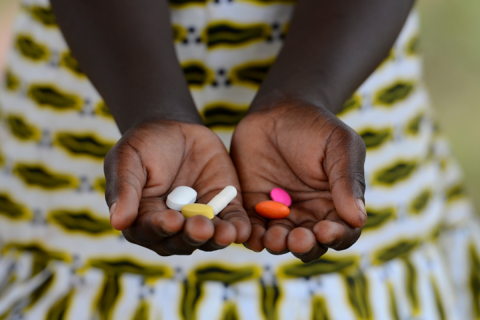Preventive use of common antibiotic reduces child mortality in Sub-Saharan Africa

Study shows giving drug ‘at scale’ is a life-saving intervention for vulnerable children.
Treating young children in Sub-Saharan Africa with azithromycin, a safe, inexpensive, and widely used antibiotic, significantly reduced deaths of children under five in a large randomised trial led by scientists at UC San Francisco.
The finding could help speed progress toward the United Nations’ goal of ending preventable child deaths by 2030.
Researchers randomised 1,533 communities in Niger, Malawi, and Tanzania, so that all young children in a given community received either a single dose of oral azithromycin or a placebo four times over two years. During visits to these communities, the researchers enrolled all the children they could find who were between one month and five years old – about 190,000 children each time. By the end of the trial, child mortality in the azithromycin-treated communities was 13.5% lower overall than it was in the communities that received the placebo.
Simple intervention to prevent children dying
The results of the study (the French name for which is abbreviated “MORDOR”) were published 25 April 2018, in The New England Journal of Medicine.
“The study shows we can prevent young children from dying with a simple intervention,” said Jeremy Keenan, MD, MPH, the study’s first author.
Keenan is a professor of ophthalmology and director of international programmes at the Francis I. Proctor Foundation at UCSF, which has overseen long-standing programmes in Africa that give antibiotics to entire communities to prevent blindness from an infectious disease known as trachoma.
“We could scale our newly studied intervention to reach millions of vulnerable children in resource-poor countries, in much the same way that trachoma programmes, which give children and adults a single dose of azithromycin each year, have been doing for years,” he said.
The scientists said more research is needed to determine exactly how the drug prevented children from dying. Although the mechanism of azithromycin’s effect on mortality has yet to be determined, it may act against microbes that can cause respiratory infections, diarrheoa and malaria, three of the biggest killers for children under five years old.
Huge drop in child mortality in Niger
The largest effects were seen in Niger, where more than 10% of children die by their fifth birthday. Child mortality in the azithromycin-treated communities there fell by 18%. The results were less dramatic in Malawi and Tanzania, where childhood mortality rates are lower than they are in Niger.
The researchers said that although giving azithromycin widely could foster antibiotic resistance – the evolution of bacterial strains that are resistant to the drug – the evidence from trachoma elimination programmes suggests such resistance would be to macrolide antibiotics, such as azithromycin and erythromycin, and not necessarily to other classes of antibiotics, such as penicillin, which are used in Africa as first-line treatments for respiratory infections.
“Treating only young children may select for less resistance than treating the entire community, as we’ve done in trachoma programmes,” said Thomas Lietman, MD, professor of ophthalmology and director of the Proctor Foundation at UCSF, the study’s senior author.
“The potential for resistance will have to be balanced against the potential to save the lives of thousands of young children.”
Youngest children benefitted the most
He noted that the youngest children in the study, those most vulnerable to life-threatening diseases, benefited the most from receiving azithromycin. Deaths among one to five-month-olds fell by nearly 25%, nearly double the rate of the group overall.
In response to the findings, the World Health Organization announced the formation of a guidelines development group to review evidence from MORDOR and other azithromycin intervention studies.
This is the first of several steps in the process that WHO uses to develop treatment guidelines. The study was funded by the Bill & Melinda Gates Foundation and run in partnership with researchers from The Johns Hopkins University School of Medicine and the London School of Hygiene & Tropical Medicine.
“This study shows that azithromycin, which has been so effective in reducing trachoma, has the potential to save the lives of young children who live in places where a child dying before their fifth birthday is a tragically common event,” said Rasa Izadnegahdar, MD, MPH, a deputy director in the global health division of the Bill & Melinda Gates Foundation.
Antibiotic resistance must be monitored
“While we will need to keep an eye on antibiotic resistance and identify the best way to deliver this intervention in some of the hardest-to-reach communities where we partner, we are optimistic that this will be a new tool to help prevent childhood mortality.”
Pfizer Inc., which has donated more than 730 million doses of azithromycin, or Zithromax, for the treatment of trachoma, provided the study drug which was administered orally, along with a placebo made to match its look and taste.
“MORDOR provides a breakthrough in our understanding of how we can best support the global community in future collaborations to improve survival of young children in countries with high mortality rates,” said Charles Knirsch, MD, MPH, vice president, Pfizer Worldwide Research and Development and an infectious diseases researcher who has helped lead Pfizer’s scientific and regulatory support of the global trachoma elimination programme since 1997.
“These important results confirm what we had previously observed about the benefits to children in studies who participated in the mass drug administration for trachoma in Sub-Saharan Africa over the last 20 years,” Knirsch said, “and they are remarkable not only for child survival but also to continued evidence of the safety of our long-standing trachoma programme.”